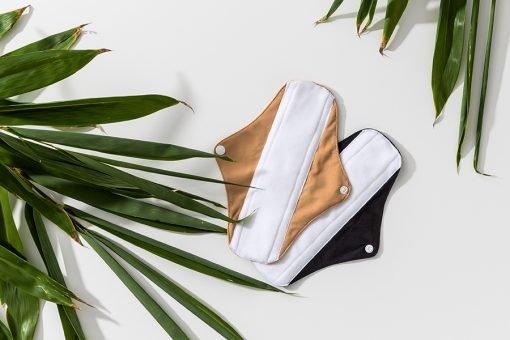Premium roofing choices shape a home’s character, efficiency, and long-term sustainability. From natural slate and standing-seam metal to clay tiles, impact-resistant shingles, and modern green roof systems, each material blends durability with environmental responsibility. These high-end options enhance insulation, reduce energy use, and support eco-conscious living-values we highlight often at the Friendly Turtle EcoBlog. Whether you’re upgrading for longevity, curb appeal, or greener performance, choosing sustainable roofing materials ensures your home stays protected while reducing its environmental footprint. Thoughtful roofing isn’t just a design choice; it’s an investment in resilience, efficiency, and a more sustainable future.
Share your articles with us and get published! Reach out at hello@friendlyturtle.com.
Reduce Your Waste by Using Reusable Sanitary Pads

Disposable sanitary pads are bad for the planet and for the health. Luckily, more and more women are warming up to the idea of using more eco-friendly alternatives; from menstrual cups to reusable sanitary pads. Are you interested in making the switch but are not quite sure where to start? Here’s everything you need to know:
Harmful effects of disposable sanitary pads
How are sanitary pads made? Many people don’t realize that so many chemicals are involved in the process. And because sanitary pads are designed to press against a sensitive area, the dioxin and rayon components can permeate through the skin. Dioxin, the chemical responsible for a pad's white colour, is a by-product of chlorine bleaching. Over time, this pollutant can accumulate inside your body and lead to hormonal dysfunction and endometriosis. Some disposable pads even contain traces of pesticides due to the cotton they're made with. This is highly unsafe for your body, causing side effects like infertility, thyroid malfunction, and diabetes.
The benefits of using reusable sanitary pads
Besides the harmful effects on your body, disposable pads are also terrible for the environment. After all, they're partly made of plastic, which is one of the world's greatest pollutants!
It's time to switch to a healthier, more eco-friendly alternative. It’s time to try a reusable sanitary pad! These feminine hygiene products are made of all-natural materials: bamboo charcoal, microfibre, and waterproof PUL to ensure maximum absorption while keeping you comfortable throughout the day.
What's great is that you can buy different reusable pads according to your menstrual flow! A lighter pad comes with one layer of microfibre, while heavier alternatives come with up to three microfibre layers.
Make sure to buy your sanitary pads from an ethical and eco-conscious store to ensure that you are getting truly sustainable environmentally-friendly products of the highest quality.
0 comments
Let customers speak for us
Blog posts
Breaking free from addiction is never simple, but small, mindful steps can create powerful change. Isolation, emotional overwhelm and unhealthy environments often make recovery feel impossible - yet reconnecting with supportive people, seeking professional help when needed, and reshaping your surroundings can open the door to real progress. On the Friendly Turtle EcoBlog, we explore how compassionate self-care, environmental awareness and healthier daily habits can nurture long-term wellbeing. From creating positive spaces to listening to your body’s signals, this gentle, sustainable approach helps you rebuild balance and resilience. No journey is linear, but with patience and the right support, recovery becomes a path back to clarity, strength and a more grounded life.
Upgrading old windows and doors is one of the simplest ways to create a warmer, quieter and more energy-efficient home. Many UK households lose heat through ageing frames, weak seals or single glazing, leading to higher heating bills and cold corners that never quite warm up. Modern A-rated designs with tighter seals and double or triple glazing help keep heat indoors, reduce draughts, cut noise pollution and even improve security. They also prevent condensation and damp around the sills, making your home feel healthier and more comfortable all year round. On the Friendly Turtle EcoBlog, we explore how energy-efficient fittings support sustainable living, lower carbon footprints and add value to your property. If winter chills are creeping in, upgrading your windows and doors could be the eco-friendly change that makes daily life noticeably warmer and quieter.



